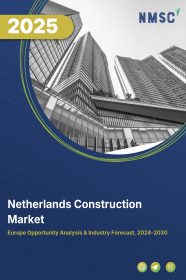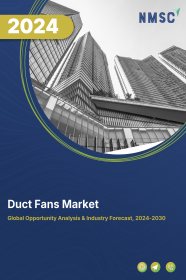
Netherlands Construction Market by Type (Renovation and New Construction), and by Sector (Real Estate, Infrastructure, and Industrial)–Opportunity Analysis and Industry Forecast, 2024–2030
Industry: Construction & Manufacturing | Publish Date: 22-Jan-2025 | No of Pages: 143 | No. of Tables: 108 | No. of Figures: 53 | Format: PDF | Report Code : CM2204
US Tariff Impact on Netherlands Construction Market
Trump Tariffs Are Reshaping Global Business
Netherlands Construction Market Overview
The Netherlands Construction Market size was valued at USD 730 million in 2023, and is predicted to reach USD 995 million by 2030, at a CAGR of 5.8% from 2024 to 2030.
The construction industry, encompassing infrastructure, plays a vital role in the economy. It oversees the entire process from initial planning to ongoing maintenance of various physical structures, including infrastructure, buildings, and facilities. This sector spans a wide array of projects, such as residential, commercial, industrial, civil engineering, and institutional infrastructure developments.
It requires collaboration among multiple stakeholders, including architects, engineers, contractors, suppliers, developers, investors, and government agencies. The industry is poised for growth, driven by an increased focus on environmentally sustainable practices, such as the use of green building materials and energy-efficient designs. Additionally, factors such as rising per capita income in emerging economies and low-interest rates in developed nations are expected to further drive the expansion of the infrastructure market.
Major Infrastructure Projects Fuels Market Growth
The construction market in this country is experiencing substantial growth, fueled by a surge in major infrastructure endeavours. Prominent projects in 2022 included the Hollands Kust Noord Wind Farm (759MW) in the Netherlands, the Rotterdam Biofuels Plant in South Holland, the redevelopment of the Simeon en Anna Nursing and Care Home in South Holland, the Brink Tower Residential Building in North Holland, and the Zaan Bridge Development in North Holland. These projects are pivotal factors driving the expansion of the infrastructure industry in the country.
Significant Contribution to GDP Boosts the Market Growth
The overall market expansion is also attributed to the significant growth of the construction market, holds a substantial portion of the GDP. According to a report by UNECE, the infrastructure sector in the Netherlands accounted for 4.7% of the country's GDP in 2022. This percentage is higher than that of other European nations, such as Greece and Ireland, highlighting the significant role of the infrastructure sector in the Dutch economy.
Regulatory Challenges Hindering Construction Market Growth
The construction market faces significant hurdles due to regulatory complexities that stem from stringent frameworks. Infrastructure ventures encounter obstacles arising from a complex network of government regulations and permitting processes. Infrastructure projects require securing numerous permits and approvals from governmental bodies at local, regional, and national levels, covering zoning regulations, environmental assessments, building codes compliance, safety standards, and various regulatory requirements.
Lengthy permit acquisition processes, bureaucratic inefficiencies, and regulatory disparities among jurisdictions can considerably extend project timelines and increase costs. Moreover, fluctuations in regulations or unexpected policy changes can disrupt ongoing projects and deter potential investments.
Integration of Digitalization and BIM Presents Lucrative Opportunity for Market Expansion
The construction market is undergoing a significant transformation through digitalization and the adoption of Building Information Modeling (BIM), leveraging advanced technologies to enhance efficiency, accuracy, and collaboration across projects. BIM, an advanced 3D modeling tool, enables stakeholders to create and oversee digital representations of structures and infrastructure, facilitating improved coordination and communication among project teams.
For instance, in September 2022, the National Institute of Building Sciences (NIBS) launched the Netherlands National Building Information Management (BIM) Program, aiming to revolutionize the infrastructure industry and achieve unprecedented levels of industrial efficiency through digitalization. This initiative addresses the insufficient degree of digitalization within the Netherlands infrastructure sector, aiming to make lifecycle work processes more efficient, cost-effective, resilient, and safer for infrastructure and maintenance.
Competitive Landscape
The market players operating in the Netherlands infrastructure industry include Heijmans N.V., ROYAL BAM GROUP NV, VolkerWessels, Dura Vermeer, TBI Holdings BV, BESIX, Van Wijnen Group, Hurks, Boskalis, Ballast Nedam, Strukton, DPR Constructions, Van Oord, FCC Construccion, Fluor Corporation, and others.
Netherlands Construction Market Key Segments
By Type
-
Renovation
-
New Construction
By Sector
-
Real Estate
-
Residential
-
Affordable
-
Luxury
-
-
Commercial
-
Retail Buildings
-
Office Buildings
-
Hospitality
-
Healthcare Facilities
-
Educational Institutes
-
Entertainment Ventures
-
-
-
Infrastructure
-
Transportation
-
Airport
-
Port
-
Rail
-
Road
-
-
Water and Wastewater
-
Energy
-
Telecommunication
-
-
Industrial
-
Manufacturing Plant
-
Warehouses
-
Power Plants
-
Oil Refineries
-
Chemical Plants
-
Key players
-
Heijmans N.V.
-
ROYAL BAM GROUP NV
-
VolkerWessels
-
Dura Vermeer
-
TBI Holdings BV
-
BESIX
-
Van Wijnen Group
-
Hurks
-
Boskalis
-
Ballast Nedam
-
Strukton
-
DPR Constructions
-
Van Oord
-
FCC Construccion
-
Fluor Corporation
REPORT SCOPE AND SEGMENTATION:
|
Parameters |
Details |
|
Market Size in 2023 |
USD 730 Million |
|
Revenue Forecast in 2030 |
USD 995 Million |
|
Growth Rate |
CAGR of 5.8% from 2024 to 2030 |
|
Analysis Period |
2023–2030 |
|
Base Year Considered |
2023 |
|
Forecast Period |
2024–2030 |
|
Market Size Estimation |
Million (USD) |
|
Growth Factors |
|
|
Companies Profiled |
15 |
|
Market Share |
Available for 10 companies |
|
Customization Scope |
Free customization (equivalent up to 80 working hours of analysts) after purchase. Addition or alteration to country, regional, and segment scope. |
|
Pricing and Purchase Options |
Avail customized purchase options to meet your exact research needs. |

















 Speak to Our Analyst
Speak to Our Analyst

















